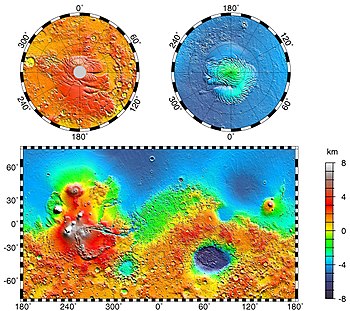
Back فرضية محيط المريخ Arabic Mars ocean theory English Teoría del océano en Marte Spanish Oceanus Borealis French Oceanus Borealis HT Teoria dell'oceano su Marte Italian Ocean na Marsie Polish Hipótese dos oceanos de Marte Portuguese Північний океан (Марс) Ukrainian 火星海洋假说 Chinese


The Mars ocean theory states that nearly a third of the surface of Mars was covered by an ocean of liquid water early in the planet's geologic history.[2][3] This ocean is called Paleo-Ocean[1] or Oceanus Borealis (/oʊˈsiːənəs ˌbɒriˈælɪs/ oh-SEE-ə-nəs BORR-ee-AL-iss). [4] It would have filled the basin Vastitas Borealis in the northern hemisphere. This region lies 4–5 km (2.5–3 miles) below the mean planetary elevation. It would have existed approximately 4.1–3.8 billion years ago. Evidence for this ocean includes geographic features resembling ancient shorelines, and the chemical properties of the Martian soil and atmosphere.[5][6][7] Early Mars would have required a denser atmosphere and warmer climate to allow liquid water to remain at the surface.[8][9][10]
- ↑ 1.0 1.1 Brandenburg, John E. (1987). The Paleo-Ocean of Mars. Lunar and Planetary Institute. pp. 20–22. Bibcode:1987meca.symp...20B.
- ↑ Clifford, S. M.; Parker, T. J. (2001). "The Evolution of the Martian Hydrosphere: Implications for the Fate of a Primordial Ocean and the Current State of the Northern Plains". Icarus. 154 (1): 40–79. Bibcode:2001Icar..154...40C. doi:10.1006/icar.2001.6671.
- ↑ Rodriguez, J. Alexis P.; Kargel, Jeffrey S.; Baker, Victor R.; Gulick, Virginia C.; et al. (8 September 2015). "Martian outflow channels: How did their source aquifers form, and why did they drain so rapidly?". Scientific Reports. 5 (1): 13404. Bibcode:2015NatSR...513404R. doi:10.1038/srep13404. PMC 4562069. PMID 26346067.
- ↑ Baker, V. R.; Strom, R. G.; Gulick, V. C.; Kargel, J. S.; Komatsu, G.; Kale, V. S. (1991). "Ancient oceans, ice sheets and the hydrological cycle on Mars". Nature. 352 (6336): 589–594. Bibcode:1991Natur.352..589B. doi:10.1038/352589a0.
- ↑ "Mars: The planet that lost an ocean's worth of water".
- ↑ "NASA finds evidence of a vast ancient ocean on Mars". MSN.
- ↑ Villanueva, G.; Mumma, M.; Novak, R.; Käufl, H.; Hartogh, P.; Encrenaz, T.; Tokunaga, A.; Khayat, A.; Smith, M. (2015). "Strong water isotopic anomalies in the martian atmosphere: Probing current and ancient reservoirs". Science. 348 (6231): 218–21. Bibcode:2015Sci...348..218V. doi:10.1126/science.aaa3630. PMID 25745065.
- ↑ Fairén, A. G. (2010). "A cold and wet Mars Mars". Icarus. 208 (1): 165–175. Bibcode:2010Icar..208..165F. doi:10.1016/j.icarus.2010.01.006.
- ↑ Fairén, A. G.; et al. (2009). "Stability against freezing of aqueous solutions on early Mars". Nature. 459 (7245): 401–404. Bibcode:2009Natur.459..401F. doi:10.1038/nature07978. PMID 19458717.
- ↑ Fairén, A. G.; et al. (2011). "Cold glacial oceans would have inhibited phyllosilicate sedimentation on early Mars". Nature Geoscience. 4 (10): 667–670. Bibcode:2011NatGe...4..667F. doi:10.1038/ngeo1243.